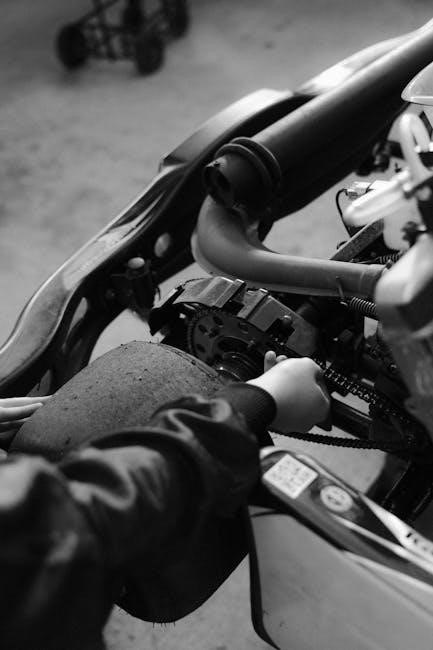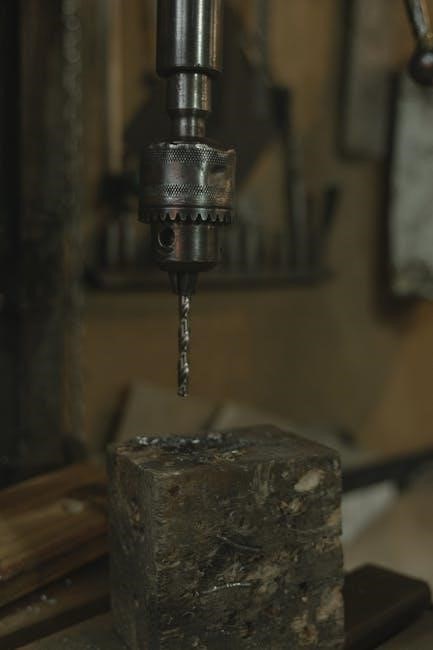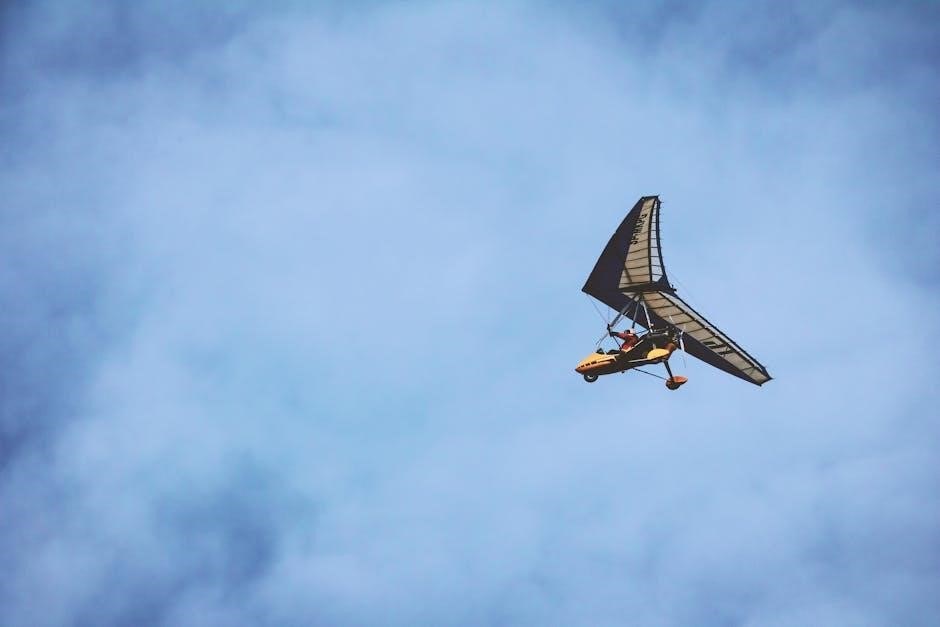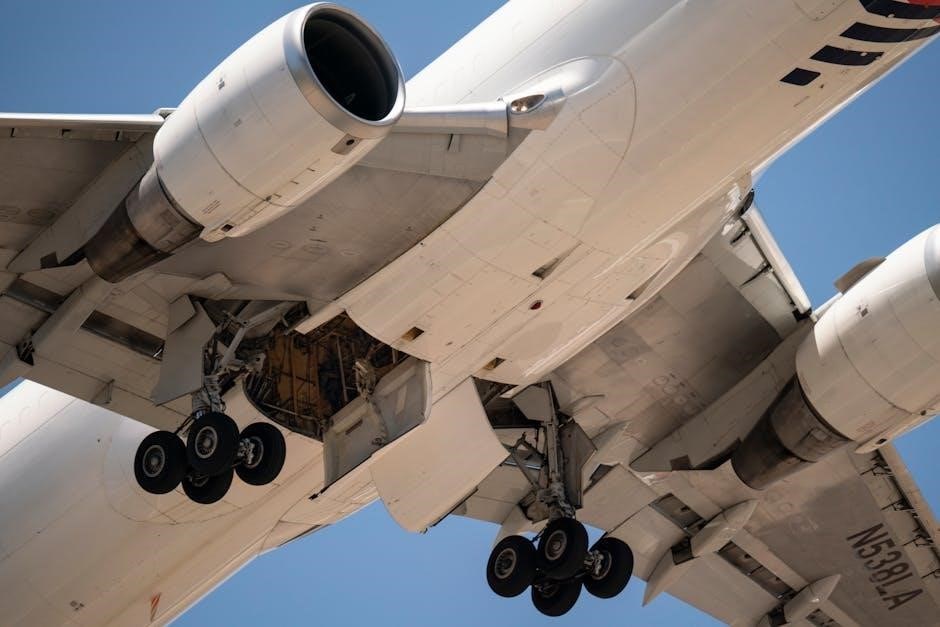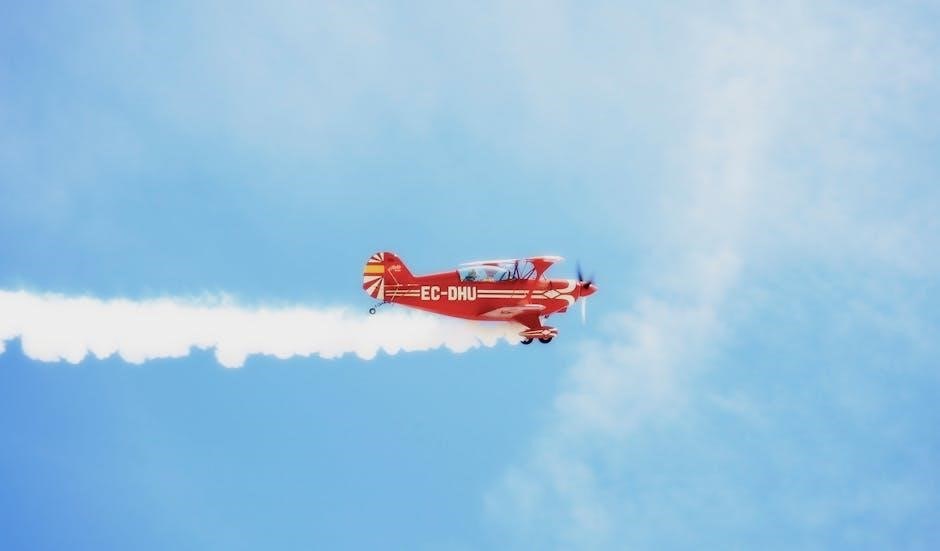The Pathfinder Roleplaying Game Bestiary PDF is a comprehensive compendium of creatures, monsters, and adversaries for the Pathfinder RPG system. It offers detailed stat blocks, lore, and artwork, providing GMs with a rich resource for populating their campaigns. Available in various editions, including Bestiary 1, 2, and 3, each volume introduces new creatures, from classic fantasy monsters to exotic beings. The PDF format ensures easy access and portability, making it a staple for both new and veteran players. With hundreds of creatures to explore, the Bestiary PDF enhances gameplay and storytelling in the Pathfinder universe.
Overview of the Pathfinder Roleplaying Game
The Pathfinder Roleplaying Game is a tabletop RPG that builds on the d20 System, offering a rich, flexible framework for character creation and storytelling. Players choose from diverse races, classes, and backgrounds, crafting unique heroes to explore vast worlds. The game emphasizes strategic combat, skill-based progression, and collaborative narrative experiences. With a focus on customization, Pathfinder allows players to tailor their characters to fit their preferred playstyle. Its extensive rule set provides depth for seasoned players while remaining accessible to newcomers. The game’s popularity stems from its balance of complexity and creativity, making it a cornerstone of modern tabletop roleplaying.
Importance of the Bestiary in the Pathfinder RPG
The Pathfinder Bestiary is a cornerstone of the RPG, providing a vast array of creatures, monsters, and adversaries essential for crafting engaging campaigns. It offers detailed stat blocks, lore, and ecological context, enabling GMs to create balanced encounters and immersive worlds. The Bestiary enhances gameplay by supplying a diverse roster of foes, from classic fantasy monsters to unique, exotic beings. Its content enriches storytelling, allowing GMs to challenge players with meaningful adversaries while expanding the game’s lore. By offering both combat and narrative tools, the Bestiary is indispensable for shaping adventures and ensuring endless variety in encounters, making it a must-have resource for any Pathfinder campaign.

Key Features of the Bestiary PDF
The Pathfinder Bestiary PDF offers a wealth of features designed to enhance gameplay and convenience. It includes high-quality digital artwork and detailed stat blocks for hundreds of creatures, monsters, and NPCs. The PDF is fully searchable, allowing GMs to quickly find specific entries. Layered PDFs enable customization, such as toggling annotations or artwork. It also features hyperlinked references, making rule navigation seamless. The PDF is compatible with popular virtual tabletop platforms, ensuring easy integration into online play. Additionally, it includes bookmarks and a comprehensive index for quick access to any entry. These features make the Bestiary PDF an indispensable tool for GMs and players alike, combining utility and depth in a user-friendly format.
Pathfinder Roleplaying Game Bestiary 1
Pathfinder Bestiary 1 introduces core creatures, essential monsters, and iconic races, serving as the foundation for the series and future expansions with classic fantasy elements.
The Pathfinder Roleplaying Game Bestiary 1 is the cornerstone of the series, offering a vast array of creatures, monsters, and races. As the first installment, it provides essential content for both players and Game Masters, introducing iconic fantasy creatures like dragons, goblins, and undead. This foundational book sets the standard for future bestiaries, delivering detailed stats, abilities, and lore. Its comprehensive coverage ensures that every campaign has a rich ecosystem of enemies and allies. Bestiary 1 is indispensable for enhancing storytelling and combat encounters, making it a must-have resource for the Pathfinder RPG community. It lays the groundwork for endless adventure and creativity.
Core Creatures in Bestiary 1
The Pathfinder Roleplaying Game Bestiary 1 introduces a diverse array of core creatures that define the game’s fantasy world. From iconic beasts like dragons and griffins to classic foes such as goblins, kobolds, and undead, this section provides essential enemies for any campaign. It also includes versatile creatures like golems and elementals, offering a wide range of challenges for players. Each entry is detailed with stats, abilities, and lore, making them ready-to-use in any adventure. These core creatures serve as the backbone of the Pathfinder RPG, ensuring that every encounter is engaging and memorable. Their variety and depth make Bestiary 1 a vital resource.
Special Features of Bestiary 1
Bestiary 1 stands out with its detailed stat blocks, ensuring each creature is game-ready. It introduces iconic monsters like dragons and liches, alongside unexpected foes. The book includes universal monster rules, enhancing customization. Monster templates allow GMs to modify creatures, adding versatility. With over 350 entries, it covers a wide range of challenges. The art and lore provide depth, enriching encounters. Bestiary 1 is a cornerstone for any Pathfinder campaign, offering flexibility and inspiration for unique adventures. Its comprehensive design makes it indispensable for both new and experienced players, providing endless possibilities for storytelling and combat.
Pathfinder Roleplaying Game Bestiary 2
Pathfinder Bestiary 2 expands the creature collection, offering new monsters and customization options for GMs to enhance gameplay with fresh challenges and depth, building on the foundation of Bestiary 1.

Pathfinder Roleplaying Game Bestiary 2 is the second installment in the iconic Bestiary series, expanding the vast array of creatures for the game. It introduces hundreds of new monsters, from classic fantasy staples to innovative designs, providing GMs with unparalleled options to craft unique encounters. This volume builds upon the foundation of Bestiary 1, offering a wider variety of challenges and themes to enrich campaigns. With detailed stat blocks, lore, and artwork, Bestiary 2 enhances gameplay by giving players and GMs alike a deeper immersion into the Pathfinder world. Its release solidified its place as a core resource for any Pathfinder RPG collection.

New Creatures in Bestiary 2
Pathfinder Roleplaying Game Bestiary 2 introduces a vast array of new creatures, expanding the game’s monster roster with fresh challenges and encounters. From fearsome demons to mysterious fey, this volume adds over 300 unique beings, each with detailed stats and lore. Classic creatures like the jabberwock and minotaur are reimagined, while entirely new monsters, such as the dream spider and necrophidius, offer innovative threats. These additions enhance gameplay by providing GMs with diverse enemies and allies, allowing for richer storytelling and strategic combat. The variety ensures that every encounter feels fresh and dynamic, catering to both seasoned players and newcomers alike.
Advanced Monster Templates in Bestiary 2
Pathfinder Roleplaying Game Bestiary 2 introduces advanced monster templates, empowering Game Masters to customize creatures for unique encounters. These templates allow for the creation of complex monsters by modifying existing creatures with powerful abilities. From the dreaded lich template to the vampiric curse, these tools enable GMs to craft foes tailored to their campaigns. The templates include options for altering creature types, adding elemental traits, or infusing magical powers, ensuring no two encounters feel the same. This flexibility enhances gameplay by providing infinite possibilities for monster customization, making every battle a fresh and exciting challenge for players.

Pathfinder Roleplaying Game Bestiary 3
Released in 2013, Pathfinder Roleplaying Game Bestiary 3 expands the creature catalog with over 300 new monsters, including mythical beings, iconic creatures, and powerful outsiders. It introduces new undead templates, expanded demon and devil entries, and unique player races, offering GMs and players fresh options for encounters and character creation. The book also updates classic monsters with new abilities, making it a versatile resource for enhancing Pathfinder campaigns with diverse and challenging foes.
Pathfinder Roleplaying Game Bestiary 3, released in 2013, marks a significant expansion to the game’s creature catalog. It introduces over 300 new monsters, ranging from mythical beings to iconic creatures, offering fresh challenges for players. The book includes new undead templates, expanded demon and devil entries, and unique player races, enhancing both encounters and character creation. Bestiary 3 also updates classic monsters with fresh mechanics, providing GMs with versatile tools to craft engaging stories. Its diverse content enriches the Pathfinder universe, making it an essential resource for both seasoned campaigners and newcomers seeking to expand their monster roster.
Expanded Creature Details in Bestiary 3
Bestiary 3 offers extensive details about creatures, enhancing their lore, habitats, and behaviors. Players and GMs gain deeper insights into iconic monsters like demons, devils, and dragons, with expanded descriptions of their origins and roles in the game world. The book also includes detailed stat blocks, variant creature templates, and ecological information, allowing for more immersive encounters. Additionally, Bestiary 3 provides lore-rich entries that tie creatures to specific adventures and campaigns, making it easier for GMs to integrate them into their stories. This depth enriches gameplay, offering both tactical challenges and narrative opportunities, while expanding the Pathfinder universe’s richness and complexity for all players.
Creature Spells in Bestiary 3
Bestiary 3 introduces a wide array of creature spells, enhancing the magical capabilities of monsters and adversaries. These spells are tailored to fit the unique roles of creatures, providing GMs with tools to create dynamic encounters. From elemental attacks to enchantments, these spells add depth to creature interactions, making battles more unpredictable and engaging. Players and GMs alike benefit from this expanded magical arsenal, as it allows for more strategic gameplay and storytelling opportunities. The integration of these spells into the Pathfinder system ensures balanced and immersive encounters, enriching the overall roleplaying experience with diverse and imaginative magical challenges.

Advanced Bestiary for Pathfinder Roleplaying Game
The Advanced Bestiary enhances monster customization, offering detailed templates and variant rules to create unique creatures. It expands gameplay depth, providing GMs with versatile tools for tailored encounters.
The Advanced Bestiary is a comprehensive expansion for the Pathfinder Roleplaying Game, designed to enhance monster customization and gameplay depth. It introduces a wide array of monster templates, variant rules, and creative mechanics, allowing Game Masters to craft unique and dynamic creatures tailored to their campaigns. This resource builds upon the foundational bestiaries, offering advanced options for both experienced players and newcomers. With its focus on versatility and creativity, the Advanced Bestiary provides tools to elevate encounters, ensuring that every monster is memorable and challenging. It is a must-have for GMs seeking to expand their world’s diversity and complexity through detailed creature design.
Monster Template Compendium
The Monster Template Compendium in the Advanced Bestiary is a treasure trove of customization options for Game Masters. It includes over 100 fully detailed monster templates, each offering unique abilities and traits to transform base creatures into memorable foes. From simple modifications like adjusting size or adding elemental resistances to complex overhauls like grafting undead traits or infusing celestial powers, these templates empower GMs to craft encounters tailored to their campaigns. The compendium also provides rules for combining multiple templates, allowing for near-limitless creativity. This feature ensures that even familiar monsters can feel fresh and exciting, keeping players engaged and challenged.
Design and Development of the Advanced Bestiary
The Advanced Bestiary was crafted with meticulous attention to detail, blending creativity with balance to enhance the Pathfinder RPG experience. Developed by a team of veteran game designers, it incorporates feedback from players and GMs to ensure versatility and usability. The design process focused on creating intuitive rules for monster customization while maintaining game balance; Extensive playtesting ensured that the content is both fun and functional. The Advanced Bestiary’s development reflects Paizo’s commitment to quality, offering tools that empower Game Masters to create unique and memorable encounters, enriching their campaigns with diverse and dynamic creatures.

Freeport Bestiary
The Freeport Bestiary is a thrilling collection of creatures tailored for the Freeport setting, offering sea monsters, pirate-themed foes, and unique nautical hazards for adventures.
The Freeport Bestiary is a unique collection of creatures and adversaries designed specifically for the Freeport setting, a pirate-themed adventure hub in the Pathfinder Roleplaying Game. This Bestiary offers a wide array of sea monsters, nautical hazards, and pirate-themed foes, enhancing the maritime adventures of players and Game Masters alike. It seamlessly integrates with the Freeport setting, providing rich lore and stats for creatures that inhabit the high seas, mysterious islands, and sunken ruins. The Freeport Bestiary is a must-have resource for any Pathfinder campaign looking to expand its nautical-themed encounters, offering depth, variety, and excitement for both seasoned and new players.
Authors and Contributors

The Freeport Bestiary is the result of a collaborative effort by renowned authors and designers in the Pathfinder community. Notable contributors include Keith Baker, creator of the Eberron setting, and Nicolas Logue, known for his work on Pathfinder Adventure Path. Additional contributions come from Greg A. Vaughan and other veteran RPG designers, ensuring a diverse and creative array of creatures. The Bestiary also benefits from community input, with fan-created content seamlessly integrated into the official release. This collaborative approach has enriched the Freeport setting, offering players and GMs a vibrant collection of monsters tailored to nautical and pirate-themed adventures. Paizo’s development team has ensured consistency and quality throughout the Bestiary, making it a standout resource for Pathfinder enthusiasts.
Key Creatures in the Freeport Bestiary
The Freeport Bestiary introduces a variety of creatures tailored to nautical and pirate-themed adventures. Iconic monsters include the Scallywag, a zombie pirate risen from the deep, and the Barnacle Hag, a sea-witch who ensnares sailors. The Swashbuckling Devil adds a fiendish twist to pirate encounters, while the Sea Serpent and Lighthouse Wight provide classic nautical threats. These creatures are designed to enhance both combat and storytelling, offering unique challenges for players. The Bestiary also includes the Shark Swarm and Merrow, perfect for underwater and coastal encounters. These additions make the Freeport Bestiary a must-have for GMs seeking to enrich their pirate-themed campaigns with diverse and imaginative foes.

Dragonbane Bestiary
The Dragonbane Bestiary presents iconic creatures like dragons and legendary beings, offering diverse challenges for high-level play and enriching Pathfinder campaigns with epic encounters.
The Dragonbane Bestiary is a unique collection of creatures tailored for high-stakes adventures, featuring iconic dragons and legendary monsters. Designed to inspire epic encounters, it offers a fresh array of foes for both new and veteran players. The Bestiary delves into the lore and mechanics of these powerful beings, providing detailed stats and strategies. Whether you’re battling a fiery dragon or outwitting a cunning lich, this supplement elevates combat and storytelling in your Pathfinder campaign. Its compatibility with Pathfinder 2nd Edition ensures versatility, making it a must-have for GMs seeking to challenge their players with unforgettable adversaries.
Features of the Dragonbane Bestiary
The Dragonbane Bestiary offers a rich assortment of creatures, including iconic dragons and other formidable monsters, each with detailed stat blocks and lore. It provides balanced encounters for various party levels, ensuring challenges for both newcomers and seasoned adventurers. The Bestiary includes unique monster templates and variant rules, enhancing customization options for GMs. Its design emphasizes both flavor and mechanics, making it a versatile tool for crafting engaging stories and battles. With compatibility across Pathfinder editions, it seamlessly integrates into existing campaigns, offering fresh content that expands the game’s monster roster while maintaining its signature depth and complexity.
Compatibility with Pathfinder 2nd Edition
The Dragonbane Bestiary is fully compatible with Pathfinder 2nd Edition, ensuring seamless integration into modern campaigns. It includes updated stat blocks and creature mechanics that align with the 2nd Edition ruleset, such as the three-action system and revised skill mechanics. Classic monsters from earlier editions have been reimagined with new abilities and balanced for 2nd Edition play. This compatibility allows GMs to effortlessly incorporate these creatures into their current campaigns, while players can enjoy encountering iconic foes with fresh, updated designs. The Bestiary bridges the gap between editions, offering a smooth transition for fans of both systems.
Pathfinder Bestiary PDF Availability
The Pathfinder Bestiary PDF is available for purchase on Paizo’s official website and other RPG platforms, offering easy downloads and bundle options for convenience and expanded collections.
Where to Purchase the Bestiary PDF
The Pathfinder Bestiary PDF is widely available for purchase on Paizo’s official website, as well as popular RPG platforms like DriveThruRPG and the Pathfinder storefront. Players can easily access these digital versions, ensuring compatibility with virtual tabletops and offline use. Additionally, some retailers offer exclusive bundles or discounts for multiple Bestiary PDFs, making it convenient for fans to expand their collections. Purchasing directly from Paizo supports the creators and ensures you receive the most up-to-date content. Always verify the seller’s authenticity to avoid unauthorized downloads and ensure a smooth, secure transaction experience.
Downloading the Bestiary PDF

Downloading the Pathfinder Bestiary PDF is a straightforward process once purchased from authorized platforms like Paizo or DriveThruRPG. Ensure your device has sufficient storage space before initiating the download. Most platforms provide a direct download link after purchase, allowing you to access the PDF instantly. The file is typically in a universal format, compatible with both desktop and mobile devices. For optimal use, consider organizing your PDFs in a dedicated folder for easy access. Additionally, check for periodic updates or errata from Paizo, as they may release revised versions. Always download from trusted sources to avoid unauthorized or corrupted files.
Bundle Options for Bestiary PDFs
Pathfinder Bestiary PDFs are available in convenient bundle options, offering players and Game Masters cost-effective ways to expand their collections. These bundles, available on platforms like Paizo and DriveThruRPG, often include multiple Bestiary volumes in one purchase, making it easier to access a wide range of creatures, monsters, and lore. Additionally, some bundles may include the Core Rulebook or other essential resources, providing a comprehensive set of tools for both new and experienced players. Purchasing a bundle not only saves money but also seamlessly enhances gameplay by offering a diverse array of content tailored to enrich your Pathfinder experience.
Pathfinder Roleplaying Game Community
The Pathfinder RPG community actively shares resources, creates fan content, and collaborates on adventures, fostering creativity and enhancing gameplay through shared passion and innovation.
Role of the Bestiary in Community Play
The Pathfinder Bestiary PDF serves as a cornerstone for community-driven gameplay, offering a shared resource for players and GMs to craft engaging encounters and adventures. By providing a vast array of creatures, it encourages collaboration, as GMs can share custom monsters or adapt existing ones to fit their campaigns. The Bestiary also fosters creativity, allowing players to contribute their own creature designs, which often inspire others in the community. Its standardized rules ensure consistency, making it easier for groups to participate in organized play events. This shared foundation strengthens the bonds within the Pathfinder community, creating a vibrant and dynamic ecosystem of storytelling and adventure.
Community Resources for Bestiary Expansion
The Pathfinder community thrives on creativity, with numerous resources available to expand the Bestiary. Official Paizo forums and fan-created websites host thousands of custom creatures, templates, and adventures. Third-party publishers offer additional monster compendiums, while platforms like Reddit and Discord foster collaboration among fans. Community-driven projects, such as the PathfinderWiki, provide extensive databases of creatures, including those from obscure sources. These resources empower GMs to innovate and players to explore new challenges, ensuring the Bestiary remains a dynamic and evolving tool. The abundance of shared content underscores the community’s dedication to enriching the Pathfinder RPG experience for everyone.
Fan-Created Content Inspired by the Bestiary
The Pathfinder Bestiary has sparked a wave of creativity among fans, inspiring a vast array of fan-created content. From homebrew monsters to custom adventures, enthusiasts have crafted unique creatures, stat blocks, and even artwork inspired by the Bestiary. Many share their work on forums, Reddit, and personal blogs, offering fresh challenges for GMs and players alike. Some fans have developed entire campaign settings filled with original creatures, while others createconverted monsters from popular media. This grassroots creativity not only expands the game’s possibilities but also fosters a sense of community and shared passion among Pathfinder fans worldwide.
The Pathfinder Bestiary PDF is an indispensable resource, offering diverse creatures and enhancing gameplay accessibility for players and GMs alike, enriching the RPG experience.
Final Thoughts on the Pathfinder Bestiary PDF
The Pathfinder Bestiary PDF stands as a cornerstone of the Pathfinder Roleplaying Game, offering unparalleled depth and variety for both players and Game Masters. Its extensive collection of creatures, detailed lore, and strategic options elevate gameplay, providing endless inspiration for crafting unique campaigns. Whether you’re a seasoned GM or a new player, the Bestiary PDF is an indispensable resource, ensuring hours of immersive adventure. Its accessibility and comprehensive design make it a must-have for anyone seeking to enhance their Pathfinder experience, solidifying its place as a foundational tool in the world of tabletop RPGs.
Future of the Pathfinder Bestiary Series
The Pathfinder Bestiary series is poised for continued growth, with new editions and expansions on the horizon. Future releases are expected to introduce fresh creature designs, blending classic fantasy elements with innovative twists. Digital integration will likely play a larger role, offering enhanced virtual tabletop compatibility and AI-driven monster creation tools. The series may also explore niche themes, such as eco-friendly or sci-fi crossover content. Community feedback will guide development, ensuring the Bestiary remains a dynamic resource for players and GMs alike. By evolving with the gaming landscape, the Bestiary series will continue to inspire imaginative storytelling and strategic gameplay for years to come.




